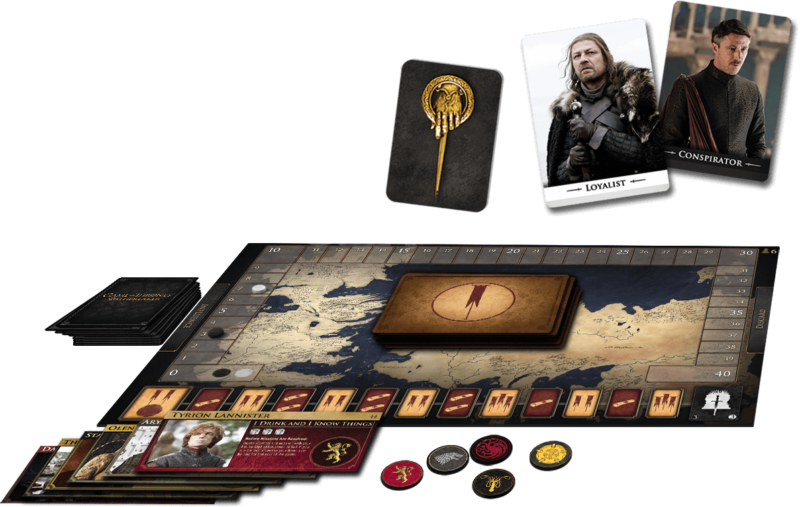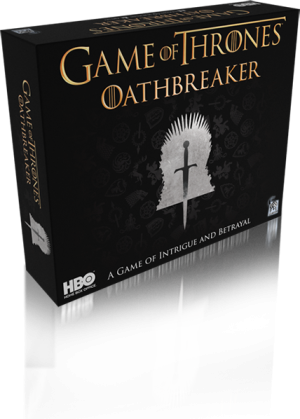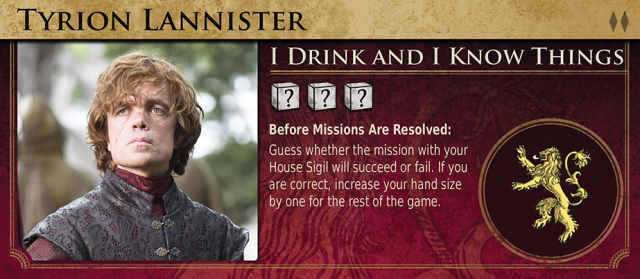
Game of Thrones: Oathbreaker is the newest game to bring the popular HBO series (and the endless George R.R. Martin book series) to tabletop, this time in a social deduction format. We already have a Game of Thrones “dudes-on-a-map” game, a deckbuilder, a hand-management bluffing game, and a very light set collection game, but nothing else in this lineage really gets into the social-deduction space popularized by titles like Coup or Deception: Murder in Hong Kong.
While Game of Thrones: Oathbreaker seems to start in the right place with its setup of loyalists vs. conspirators, the game lacks balance. It’s just too easy for the conspirator team (which starts with a large advantage anyway) to win. The king must play a nearly perfect game to take the crown.
Find the traitor

In Oathbreaker, one player takes the role of the king; everyone else plays nobles with hidden identities (either loyalist or conspirator) that the king must guess. Players may benefit from guessing which other players are on the same side as they are, but it’s not necessary to win the game.
Oathbreaker requires a minimum of five players; with eight, two players are known as the king and queen, and they split responsibilities by each dealing with three of the six nobles. Players try to push their side to victory by scoring points. They also try to achieve their individual objectives (which are hidden from other players), where they have to end the game with certain cubes representing honor or power. The loyalists’ side is called Order and is represented by a white token on the scoring track, while the conspirators’ side is called Chaos and is represented by a black token.
The game plays over a series of rounds that alternate between mission cards, where the nobles will try to complete or to sabotage, and decrees, where the king will play two cards to all nobles or to specific ones.
In each round where mission cards are played, the king turns over two or three such cards. The nobles then go around the table and play at least two of their influence cards to the missions, and then they place their sigil token on the mission where they played the most cards. Mission cards have one of three symbols—crown, raven, or swords—and carry instructions for how much to move the Order or Chaos tokens if the mission succeeds or fails. They also give rewards for players who place their sigil tokens on those missions.
After all nobles have played cards to the missions, the king collects the cards from each mission, shuffles them, and reveals them. These influence cards can have crown, raven, sword, or skull symbols, or some combination of those. If there are more symbols on these cards matching the symbol on the mission card than there are skulls, the mission succeeds. The Order token moves up, and any player with a sigil on the card gains any cube rewards shown on the success side. If there are more skulls than matching symbols, or if the two sides are equal, the mission fails. The Chaos token moves up, and for some cards the failure rewards go to players who had sigil tokens on that mission.
The king doesn’t know who played which cards to each mission, only whether a noble played any cards to a mission and how many. But one of the king’s main tasks throughout the game is to try to figure out which nobles are loyalists and which are conspirators. The king gets to “bet” on certain nobles during the decree phases by playing Loyalist and Conspirator cards directly to nobles, which will score at game end, advancing the Order token if the King guessed correctly while advancing the Chaos token if the king guessed incorrectly.
The game alternates between mission phases and decree phases until the round token reaches the end of its track, at which point the one loyalist/conspirator card that was set aside at the start of the game is revealed, moving up the Order or Chaos token accordingly. The king then guesses what side each of the nobles was on, guessing all nobles before any reveals their loyalty. The nobles then reveal their loyalty cards one by one, moving up the Order token (if decree cards played to them match their loyalty) or the Chaos token (if the decree cards didn’t match). If the king got all nobles’ loyalties correct, the Order token moves up three spaces; if even one is wrong, the Chaos token moves up.

You may have figured out by now that it’s quite hard for the king’s side (Order) to win; the deck is literally and figuratively stacked against Order. Far more missions fail than succeed. There can be an equal number of loyalists and conspirators, or one more conspirator than loyalists, but there can’t ever be more loyalists.
The card deck has 75 cards: 20 cards have only skulls (1 to 3); 10 cards show crowns, ravens, or swords; 10 cards display all of the mission symbols (not skulls); while 15 cards show one mission symbol and one skull. Each noble gets just three cards at a time. In a turn where two or three mission cards have the same symbol, the odds of a noble having only skulls and/or cards that aren't useful for those missions are high—about 29 percent for a single noble in any hand of three cards from the full deck of 75. The odds of having two of three cards that fail to match the desired mission symbol are 44 percent. For a loyalist noble, therefore, the odds that you’ll lack the cards needed to help the king’s missions succeed are way too high. Since missions fail so easily (you need more matching symbols than skulls), this creates a game-wide imbalance in favor of the conspirators.
There’s the seed of a better game in here somewhere, but ultimately Oathbreaker just doesn't give the king and his loyalists a fair chance. The deck and the scoring both skew towards the conspirators. There also isn't enough information for the king to figure out who’s on what side, or for the nobles to figure out each other’s identities beyond making mildly informed guesses. This reduces the social deduction aspects that could make the game more fun.
On top of all that, the Game of Thrones content itself is not well-integrated into the game. Each player has a character to play from the books/series, but this character is not related to the player’s powers, has no bearing on whether they’re a loyalist or a conspirator, and doesn’t determine anything about how the player acts or what they can do. There are Game of Thrones games that do incorporate the content better, like the Game of Thrones Card Game from Fantasy Flight, but Oathbreaker feels a bit more like the IP from HBO was slapped on an unrelated game.
Dire Wolf has done some great work in the digital space, such as their app versions of Lanterns and Raiders of the North Sea (and the forthcoming Yellow & Yangtze), but their original tabletop games have fallen sadly short. Include Oathbreaker in that assessment.
https://arstechnica.com/gaming/2019/11/turn-your-tabletop-into-a-real-game-of-thrones-with-oathbreaker-game/
2019-11-23 13:30:00Z
CBMibGh0dHBzOi8vYXJzdGVjaG5pY2EuY29tL2dhbWluZy8yMDE5LzExL3R1cm4teW91ci10YWJsZXRvcC1pbnRvLWEtcmVhbC1nYW1lLW9mLXRocm9uZXMtd2l0aC1vYXRoYnJlYWtlci1nYW1lL9IBAA
Bagikan Berita Ini














0 Response to "Turn your tabletop into a real Game of Thrones with Oathbreaker game - Ars Technica"
Post a Comment